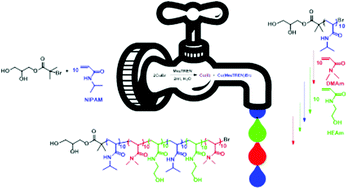Sequence-controlled multi-block copolymerization of acrylamides via aqueous SET-LRP at 0 °C†
Abstract
Aqueous single electron transfer living radical polymerization (SET-LRP) has been employed to synthesize multi-block homopolymers and copolymers of a range of acrylamide monomers including N-isopropylacrylamide (NIPAM), 2-hydroxyethyl acrylamide (HEAA), N,N-dimethyl acrylamide (DMA) and N,N-diethylacrylamide (DEA). Disproportionation of Cu(I)Br in the presence of Me6TREN in water was exploited to generate reactive Cu(0) and [CuII(Me6TREN)]Br2in situ resulting in unprecedented rates of reaction whilst maintaining control over chain lengths and molecular weight distributions (Đ < 1.10). Kinetic studies enabled optimization of iterative chain extensions or block copolymerizations furnishing complex compositions in a matter of minutes/hours. In the multi-block copolymer system, the monomer sequence was successfully varied and limiting effects on the polymerization have been comprehensively examined through a series of control experiments which imply that the rate of ω-Br chain end loss is enhanced in tertiary acrylamides (DMA, DEA, N-acryloylmorpholine NAM) relative to secondary acrylamides (NIPAM, HEAA).


 Please wait while we load your content...
Please wait while we load your content...